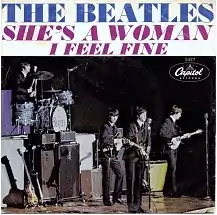She's a Woman
"She's a Woman" is a song by the English rock band the Beatles, written mainly by Paul McCartney and credited to Lennon–McCartney. John Lennon contributed to the lyrics and middle eight (the bridge). The song was finished in the studio the morning of the session. It was released as the B-side to "I Feel Fine" in 1964, their last single release that year. It reached number 4 on the Billboard Hot 100 from frequent airplay. In New Zealand, the song reached number one for one week.[1]
| "She's a Woman" | ||||
|---|---|---|---|---|
 | ||||
| Single by the Beatles | ||||
| A-side | "I Feel Fine" | |||
| Released |
| |||
| Recorded | 8 October 1964 | |||
| Studio | EMI, London | |||
| Genre | ||||
| Length | 3:03 | |||
| Label |
| |||
| Songwriter(s) | Lennon–McCartney | |||
| Producer(s) | George Martin | |||
| The Beatles US singles chronology | ||||
| ||||
| The Beatles UK singles chronology | ||||
| ||||
The song's chorus was briefly heard in the movie Help! (1965).
Composition and recording
"She's a Woman" has been described as an example of the rock and roll,[2] rhythm and blues[3] and pop rock[4] genres. The song, penned mainly by Paul McCartney (Lennon helped with the lyric and bridge) was his attempt at imitating the vocal style of Little Richard. This is why the song is in such a high register, even for McCartney's tenor range. Some takes of the song (especially recordings of live concerts) feature an extended outro. "She's a Woman" is the first Beatles song that is longer than three minutes.
The structure of the song is fairly simple, with the melody carried mostly by McCartney's voice. His bass and a backing piano produce a countermelody, with Lennon's guitar playing chords on the backbeat. After the first verse, the piano also plays chords on the upbeats. George Harrison plays a bright guitar solo during the middle eight.
Author Ian MacDonald noted in his book Revolution in the Head that the final mix of "She's a Woman" at the time of its original release was unusual of the time, with the bass kick on Starr's drum kit being barely audible due to it being compressed in the mixing process. MacDonald suggested that McCartney's bass part might be responsible for the rearrangement of the mixing as its more prominent volume was in sacrifice of the drums' usual mixing due to limiting problems.[5]
Releases
In the United States, the song was released on the Capitol album Beatles '65 with considerable reverb added by executive Dave Dexter Jr. Both mono and stereo versions were released, the stereo version presented in a duophonic (mock stereo) mix. These were released on CD in 2004 as part of The Capitol Albums, Volume 1 boxed set compilation.
A genuine stereo version of the song was released in 1987 on the Past Masters, Volume 1 CD; the true mono version was not made available in CD format until 2009 as part of The Beatles in Mono boxed set compilation.
There is also another stereo version that sounds the same but with McCartney's count-in which appears on the CD EP box set. This stereo version with the count-in also appeared on a bonus stereo vinyl EP included with an earlier vinyl EP box set. The song is heard being played on a tape recorder underground during the Salisbury Plain scene in the movie Help!. In the UK, the first album release was on the 1978 compilation LP Rarities in mono in the box set The Beatles Collection and later released separately.
The band started including the song in their live shows in 1965. It is characterised by the classic percussive "honk" of Lennon's Rickenbacker 325. One of the versions of the song can also be found on the Beatles' live albums, Live at the Hollywood Bowl and Live at the BBC, while a version from the first of two shows at Nippon Budokan in Tokyo in 1966 appears on Anthology 2.
On the US charts, the song was the final of 11 top ten hits in the calendar year 1964, giving the Beatles an all-time record for most top ten hits in a calendar year on the Billboard Hot 100 charts by one artist/group (surpassed by rapper Drake in 2018).[6] It was also the twelfth top 10 hit written by Lennon–McCartney, an all-time record for most top 10 hits in a calendar year on the Billboard Hot 100 by a songwriter.
Personnel
- Paul McCartney – vocal, bass
- John Lennon – rhythm guitar
- George Harrison – double-tracked lead guitar
- Ringo Starr – drums, chocalho
- George Martin – producer, piano
- Norman Smith – engineer
Notes
- Flavour of New Zealand, 21 January 1965
- Michael R. Frontani (18 September 2009). The Beatles: Image and the Media. Univ. Press of Mississippi. p. 113. ISBN 978-1-60473-156-9. Retrieved 24 October 2015.
- Tim Riley (2002). Tell Me Why: The Beatles: Album by Album, Song by Song, the Sixties and After. Da Capo Press. p. 118. ISBN 978-0-306-81120-3. Retrieved 24 October 2015.
- Terence J. O'Grady (1 May 1983). The Beatles: A Musical Evolution. Twayne Publishers. p. 56. ISBN 978-0-8057-9453-3.
Both "I Feel Fine" and "She's a Woman" are heavily rhythm and blues influenced pop-rock songs.
- Ian MacDonald "Revolution in the Head"
- Trust, Gary (22 October 2018). "Drake Scores 12th Billboard Hot 100 Top 10 of 2018, Passing The Beatles for the Most in a Single Year". Billboard. Retrieved 22 October 2018.
- Winn 2009, p. 279-284.
- Everett 2001, p. 266.
References
- "Beatles for Sale". The Beatles Interview Database. 1980. Retrieved 27 September 2009.
- MacDonald, Ian (2005). Revolution in the Head: The Beatles' Records and the Sixties (Second Revised ed.). London: Pimlico (Rand). ISBN 978-1-84413-828-9.
- "Emma Louise Layla". Wu-Tang VS The Beatles. 2010. Retrieved 21 January 2010.
